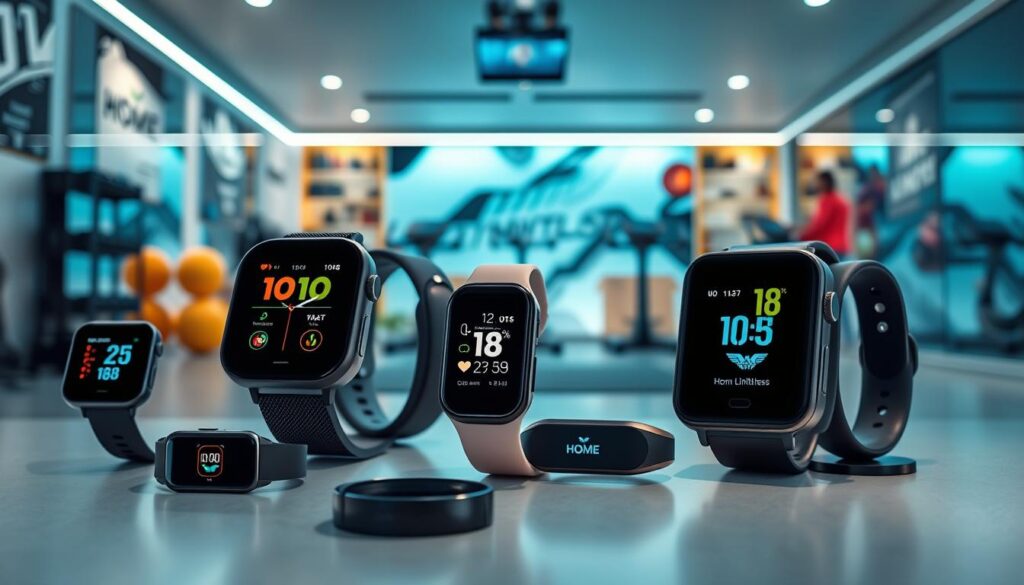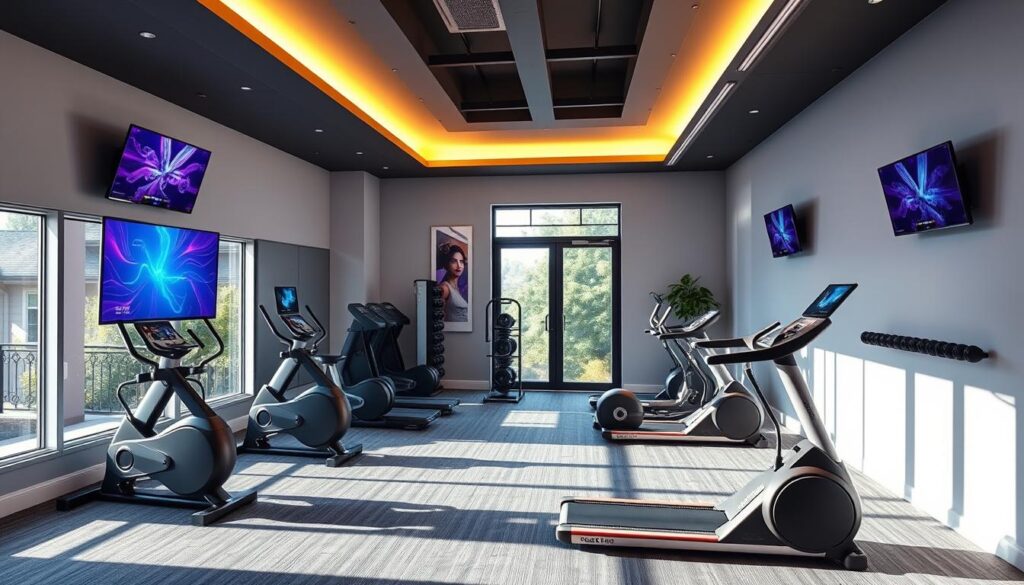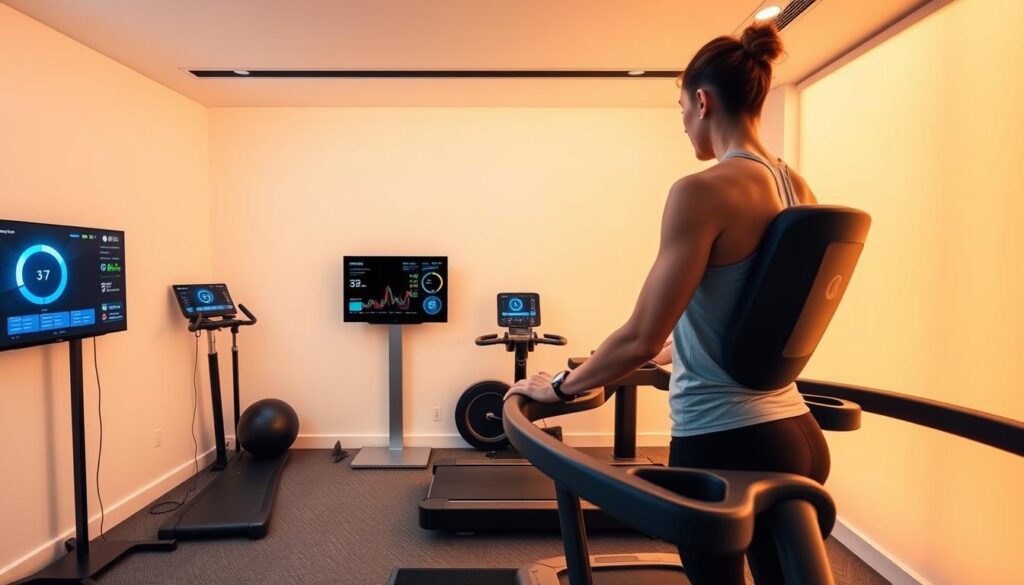Are you curious about how smart fitness technology can change your workouts? Today, tracking your fitness is easier and more detailed than ever. Smart fitness gear gives you lots of data, helping you see your health journey in a new light.
Those old days of just using a scale are over. Now, you can track your heart rate, muscle mass, body fat, and daily activity. This lets you set better goals and see improvements you might miss otherwise.
Tracking your progress with smart fitness gear is more than just numbers. It’s about knowing how your body reacts to exercise and lifestyle changes. This tech lets you make smart choices about your workouts, diet, and rest. Seeing all your health metrics at once gives you a full picture of your health, keeping you motivated and on track.
Table of Contents
Key Takeaways
- Smart fitness technology offers comprehensive health data tracking
- Progress monitoring goes beyond weight, including metrics like heart rate and body composition
- Fitness tracking helps in setting realistic goals and observing small changes
- Smart equipment provides data-driven insights for personalized workouts
- Wearable technology integrates with smart gym gear for enhanced progress tracking
Understanding the Importance of Progress Tracking
Tracking your progress is key in any fitness journey. It lets you see how you’re doing in health and performance. This helps you make smart choices about your workouts and diet.
Benefits of Monitoring Your Fitness Journey
Tracking your progress has many benefits. It gives you a clear picture of your health and helps set achievable goals. For instance, watching your resting heart rate can show if your heart health is improving.
Also, aiming for 10,000 steps a day can improve your health and mood.
How Tracking Impacts Motivation and Goal Achievement
Tracking regularly boosts motivation and helps reach goals. The goal-setting theory shows that clear, challenging goals lead to better results. By setting SMART goals and tracking them, you’re more likely to succeed.
The Role of Data in Fitness Improvement
Data helps improve fitness by showing how you’re doing. Smart devices give real-time data on heart rate, steps, and performance. This lets you fine-tune your workouts and see your progress.
| Metric | Importance | Tracking Method |
|---|---|---|
| Body Composition | Reflects changes in body fat and muscle mass | Smart scales, body scans |
| Performance Metrics | Indicates strength and endurance improvements | Smart gym equipment, fitness apps |
| Daily Activity | Assesses overall movement and calorie burn | Wearable fitness trackers, smartphone apps |
Using these tracking methods and fitness tools helps you monitor your progress. This way, you can reach your fitness goals more effectively.
Types of Smart Fitness Equipment
Smart fitness equipment has changed home workouts. It offers many options for those who love to stay fit. From connected home gyms to wearable devices, there’s something for everyone.
Connected home gyms are becoming more popular. The Tempo Studio starts at $140 monthly with a 12-month commitment. It supports up to six user profiles, great for families. For those who love cardio, the NordicTrack Commercial 2450 treadmill costs $39 monthly for a family iFit membership.
Strength training fans might like the Tonal smart home gym. It costs $3,995 and offers up to 200 pounds of resistance. Rowing enthusiasts will enjoy the Peloton Row smart rowing machine, priced at $2,995, with a 300-pound weight capacity.
Wearable devices like smartwatches track fitness metrics. They connect to smartphones, giving real-time data during workouts. Smart scales are also key. They measure body composition, helping users track their progress over time.
| Equipment | Price | Monthly Subscription | Key Features |
|---|---|---|---|
| Tempo Studio | $101 equipment fee | $39 after commitment | 6 user profiles |
| NordicTrack 2450 | Not specified | $39 (family plan) | iFit membership |
| Tonal | $3,995 | Not specified | 200 lbs resistance |
| Peloton Row | $2,995 | Not specified | 300 lbs capacity |
These smart devices track and offer personalized workouts. They’re changing home fitness, making it more fun and effective. Whether you prefer strength training, cardio, or full-body workouts, there’s a smart fitness solution for you.
Key Metrics to Monitor with Smart Fitness Devices
Smart fitness devices give you lots of data to track your progress. By focusing on key fitness metrics and health indicators, you can make your workouts better and improve your overall health.
Heart Rate and Cardiovascular Health
Watching your heart rate gives you insights into your heart health. A healthy resting heart rate is between 60-100 beats per minute. Regular aerobic exercise can lower your resting heart rate, showing better heart health.
Step Count and Daily Activity Levels
Tracking your daily steps is a simple way to measure your activity. Aiming for 10,000 steps a day can lead to longer life, better mobility, and better mental health. Smart devices help you keep track of reaching this goal.
Body Composition Measurements
Smart scales can track your body fat percentage and muscle mass. This gives you a full view of your fitness journey. These measurements are great for those trying to lose weight or build muscle.
Performance-Based Metrics
Tracking your performance helps you set and reach fitness goals. Whether you’re working on endurance, strength, or speed, smart devices can measure important indicators like time, distance, or reps. Remember, neuromuscular adaptations can happen around four weeks into a new program, affecting strength before you see physical changes.
| Metric | Benefit | Goal |
|---|---|---|
| Resting Heart Rate | Cardiovascular Health | 60-100 bpm |
| Daily Step Count | Overall Activity | 10,000 steps |
| Body Composition | Weight Management | Personalized |
| Performance Metrics | Fitness Improvement | Varies by Goal |
By regularly checking these key metrics, you can understand your fitness progress well. This helps you make smart choices about your health and workouts.
Utilizing Wearable Technology for Fitness Tracking
Wearable devices have changed how we track fitness, giving us instant health insights. Fitness trackers and smartwatches are key for those wanting to monitor their progress and reach wellness goals.

The rise of wearable tech in fitness is clear. The American College of Sports Medicine’s Worldwide Fitness Trends survey shows it’s been the top trend since 2016. It’s expected to stay the number one trend in 2024. This shows how important it is to use data to improve fitness.
Smartwatches and fitness trackers have many features to help users stay healthy:

Top brands like Fitbit, Apple, Garmin, and Samsung keep adding new features to their devices. Some smartwatches even have FDA-approved medical features, like detecting irregular heart rhythms.
| Device Type | Key Features | Popular Brands |
|---|---|---|
| Fitness Trackers | Step counting, activity tracking, sleep monitoring | Fitbit, Amazfit, Garmin |
| Smartwatches | Heart rate monitoring, GPS, smartphone integration | Apple Watch, Samsung Galaxy Watch, Garmin Fenix |
| Specialized Wearables | Advanced metrics (e.g., recovery, training load) | Whoop, Oura Ring |
While wearable devices offer valuable health data, they shouldn’t replace medical advice. They should be seen as a tool to enhance your fitness journey. Always consult a healthcare provider for any health concerns.
Smart Fitness Apps and Their Features
The fitness app market is growing fast, expected to hit $10.06 billion by 2029. These apps are changing how we view health and exercise. Let’s look at some top fitness apps and their key features.
Popular Fitness Tracking Apps
Fitness apps vary, meeting different needs. Some focus on workout tracking, while others focus on nutrition or wellness. Strava supports over 30 activities and boosts motivation with social features. Fitbit tracks activity, sleep, and heart health, offering a complete view.
Integration with Smart Equipment
Many apps now work well with wearable devices. By 2024, 35 million Bluetooth fitness trackers will be used. This lets users collect detailed data, from heart rate to steps. Peloton’s app connects with their machines, offering live and on-demand classes.
Data Analysis and Reporting Capabilities
Fitness apps shine with their data analysis. AI and machine learning offer personalized advice based on user data. MyFitnessPal uses AI to suggest workouts, helping over 100 million users.
| Feature | Benefit |
|---|---|
| Activity Tracking | Monitors daily movement and exercise |
| Workout Libraries | Provides diverse exercise options |
| Nutrition Planning | Helps balance diet with fitness goals |
| Community Support | Encourages motivation and accountability |
| AI-Powered Coaching | Offers personalized feedback and adapts workouts |
Fitness apps offer gamification, smart coaching, and data integration. They’re key for health lovers. As tech improves, we’ll see more cool features for our fitness journeys.
Connected Home Gym Equipment
Smart home gyms are changing the fitness world. They bring interactive workouts right to your living room. Let’s look at some popular choices and what they offer.

Peloton is a top choice with its Bike+ and Tread. They cost $2,495 and $2,995 on Amazon. These machines offer live and on-demand classes, track your performance, and provide personalized training.
Tonal is great for strength training and is compact. It costs $3,995. NordicTrack’s RW900 Rowing Machine is priced at $1,700 on Amazon, saving you $299. FightCamp is perfect for boxing fans at $1,219, and Forme Studio offers a fitness mirror for $2,495.
For those on a budget, MYX II is an affordable stationary bike at $1,399. Sunny Health and Fitness has smart fitness gear like adjustable dumbbells and wrist weights.
| Equipment | Price | Key Features |
|---|---|---|
| Peloton Bike+ | $2,495 | Live classes, performance tracking |
| Tonal | $3,995 | Space-saving strength training |
| NordicTrack RW900 | $1,700 | Interactive rowing experience |
| MYX II | $1,399 | Affordable stationary bike |
These smart home gyms offer more than just equipment. They provide engaging workouts, detailed tracking, and tailored training. Although they cost more than traditional gym gear, their convenience and features make them a good choice for your fitness journey.
Smart Scales and Body Composition Analysis
Smart scales have changed how we track our fitness. They do more than just weigh us, showing our body’s makeup. Let’s see how they help us understand our bodies and track our fitness.
Understanding Body Fat Percentage
Body fat percentage is key to health. Smart scales use bioelectrical impedance to guess this important number. The Etekcity HR Smart Fitness Scale, at $72, tracks body fat and 13 other metrics, showing your body’s details.
Tracking Muscle Mass Gains
For those building strength, watching muscle mass is crucial. The Oxiline Scale X Pro, at $99, tracks up to 16 metrics, including muscle mass. This shows if your workouts are building lean muscle.
Monitoring Overall Body Composition Changes
Smart scales are great for tracking body changes over time. The Renpho Smart Wi-Fi Bluetooth Body Fat Scale-Premium, at $42, syncs data via Wi-Fi and Bluetooth. This makes it easy to see trends in your body composition.
| Smart Scale | Price | Key Features |
|---|---|---|
| Wyze Scale X | $40 | 13 metrics, 8 profiles, 400 lb capacity |
| Oxiline Scale X Pro | $99 | 16 metrics, BodyEcho technology, lifetime warranty |
| Renpho Smart Scale | $42 | 13 metrics, unlimited profiles, Wi-Fi sync |
Using these smart scales regularly gives you insights into your body. This info helps you make better choices about diet and exercise. It helps you reach your fitness goals more effectively.
“Smart scales provide a window into your body’s changes, motivating you to stay on track with your fitness journey.”
Leveraging Smart Fitness Data for Goal Setting
Smart fitness data helps you set goals that match your current fitness level. It lets you see where you need to improve. This way, you can make your workouts better and track your progress more effectively.
When setting fitness goals, use the SMART framework. This means your goals should be Specific, Measurable, Achievable, Relevant, and Time-bound. For instance, instead of saying “get healthier,” aim to “lose 10 pounds in two months.” Breaking down big goals into smaller ones keeps you motivated.
Keeping an eye on your fitness data is key to setting both short-term and long-term goals. This balanced approach helps you stay on track and motivated. Using tech tools like fitness apps and wearables gives you better data access and accountability. Businesses that use data make better decisions by 5 to 10 times more than those relying on intuition.
Use your fitness data to change your goals and strategies as needed. This flexible approach helps you deal with setbacks and plateaus. With regular tracking and planning, you’re on your way to long-term fitness success.







